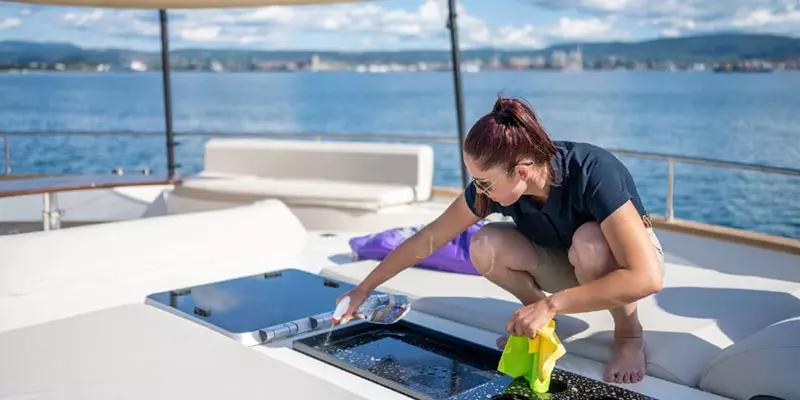A dirty yacht can cause functional and safety issues in addition to cosmetic problems. Salt deposits can lead to corrosion and pitting, marine life can grow, and various materials such as vinyl, fabric, and carpets can become damaged. It is important to clean the head regularly and maintain the fiberglass to prevent further damage.
While you may already be aware of the importance of cleaning your boat on a regular basis, few articles provide guidance on what should be included in your cleaning kit. This article aims to fill that gap.
This is what should be included in a captain’s yacht cleaning kit
Maintaining your yacht’s pristine condition involves more than just having the right cleaning kit—it’s about knowing how to utilize it effectively. Here are some heartfelt tips to ensure your yacht sparkles:
- Quality Matters: Invest in top-notch cleaning supplies that guarantee superior results. High-quality products not only clean better but also protect your yacht’s surfaces.
- Tool TLC: Treat your cleaning tools with care and respect. Proper maintenance ensures they remain effective for longer periods, saving you time and money in the long run.
- Master Technique: Knowing how to use your cleaning supplies correctly is key to achieving optimal results. Take the time to learn proper techniques and application methods for each product.
- Consistency is Key: Make cleaning a regular part of your yacht maintenance routine by creating a set schedule. Consistent upkeep prevents dirt and grime buildup, preserving your yacht’s pristine appearance.
- Stay Stocked: Keep a close eye on your cleaning supplies and replenish them promptly when running low. Regularly check for worn-out items or depleted liquid cleaners to avoid interruptions during cleaning sessions.
Remember, every item in your cleaning kit plays a vital role in maintaining your yacht’s allure. By following these heartfelt tips and staying proactive in your cleaning efforts, you’ll ensure your vessel continues to shine on the open waters.

Here are the essential items to include in a complete cleaning kit:
Buckets
The bucket is an essential tool in the fight against grime and salt spray. As you embark on your cleaning journey aboard your yacht, your bucket should be ready with the necessary cleaning supplies. This bucket should be large enough to accommodate all your cleaning essentials, such as mops, sponges, and mitts.
Now, let’s discuss practicality. While fancy buckets may catch the eye, simplicity is key. Choose a no-frills design that can be easily carried with one hand. Avoid struggling with a bulky bucket that has handles on the sides. Efficiency is the top priority here.
Depending on the size of your container, one bucket may not be sufficient. Feel free to enlist additional buckets to tackle the task at hand. A clean yacht is a happy yacht, and your buckets are essential to this maritime saga!
Mop
Mops are great for cleaning hard-to-reach areas and removing water stains. It is recommended to use a chamois mop head with good absorption qualities to effectively remove grime and dirt without causing any damage to your yacht’s surfaces.
Sponge
Sponges are useful for removing dirt, but it is important to use soft sponges to avoid scuffing your boat’s surfaces. Additionally, choose eco-friendly sponges without embedded chemicals. Be cautious when using scuff erasers as they may not be suitable for more sensitive surfaces.
Wash Mitt
The Microfiber chenille wash mitts are perfect for washing and drying your boat. They are gentle on fiberglass, paint, oiled finishes, and gel coats, effectively removing built-up grime. It is recommended to use two mitts, but be careful not to let leaves and debris get inside, as they can be difficult to remove.
Shammy Towel
When your boat is on the water, salt spray constantly attacks it. Therefore, you will need the right towel to wipe down surfaces. Shammy towels are incredibly absorbent, and you will never have to worry about leaving water spots, scratches, scuffs, or salt deposits behind.
Wash-and-Wax
To safeguard your yacht against the elements, it’s crucial to strip away dirt and shield it with a protective wax coating, thwarting any attempts by grime to mar its pristine hull. Enter the wash-and-wax duo, your dynamic cleaning duo primed to purify and polish every surface with unparalleled finesse.
Fabric Spray
The elements can be harsh on your boat’s fabric, with salt spray, rain, and even the occasional fish you reel in all testing its resilience. To keep every inch of fabric in top-notch condition, a trusty bottle of fabric spray comes into play. Whether it’s your sails billowing in the wind or the cozy seats where you unwind, this magic potion ensures that your boat’s fabric remains protected.
UV Protectant
The sun is the primary cause of environmental wear and tear on boats. It gradually degrades all materials, including wood decking and fiberglass hulls. To prevent this, apply UV protectant regularly. By staying diligent with this protective measure, you can shield your boat from sun damage. This will ensure its longevity and preserve its beauty for countless voyages to come.
The types of surfaces you need to clean
Maintaining every surface on your yacht demands a tailored approach, recognizing the unique needs of each material:
- Carpet: Begin by vacuuming away any dirt and debris. Then, scrub gently with a mixture of soap and water, ensuring thorough coverage. Allow it to dry completely before storing to prevent mold and mildew.
- Vinyl: Cleanse with a gentle soap and water solution applied with a soft rag, ensuring to wipe dry afterward to prevent water spots and streaks.
- Fiberglass: Employ a soft bristle brush and soap and water solution for a gentle yet effective clean. For non-slip fiberglass surfaces, utilize specialized non-skid products to maintain traction and safety.
- Cushions: Treat them delicately by using a soft bristle brush along with soap and water to lift away dirt and stains, ensuring not to saturate the fabric excessively.
- Chrome: Revitalize chrome surfaces by buffing away imperfections with metal wax and a soft cloth, then apply chrome polish to protect and enhance shine.
- Wood: Show your wooden surfaces some love by soaking them with water to loosen dirt. Clean across the grain with a stiff brush and a wood-safe cleaner, then rinse thoroughly while scrubbing to maintain their natural luster.
- Engine: Prioritize protection for sensitive areas with waterproof tape before cleaning. Remove debris and wipe away dirt using a paper towel. For tougher grime, utilize a degreaser diluted in water to wipe down the engine surfaces effectively.
- Windows: Flood the windows generously with fresh water to loosen dirt and salt residue, then wipe clean with a shammy cloth for a streak-free finish and crystal-clear views of the sea.
With a tailored cleaning regimen for each surface, your yacht will gleam with brilliance, ready to embark on countless adventures upon the waves.

The different types of water
Indeed, the type of water your boat encounters can significantly impact its surfaces. Here are some common types and their effects:
Saltwater: Perhaps the most notorious, saltwater poses a considerable challenge. Its corrosive nature can degrade metal fixtures, erode paint and coatings, and leave stubborn salt residue on surfaces if not promptly cleaned.
Freshwater: While generally less corrosive than saltwater, freshwater can still cause damage over time, particularly if it contains minerals or pollutants. Algae and other organic matter may also accumulate, requiring regular cleaning to prevent staining and deterioration.
Brackish Water: Found in estuaries and coastal areas where freshwater mixes with saltwater, brackish water presents a unique set of challenges. It combines the corrosive properties of saltwater with the potential for mineral buildup found in freshwater, requiring careful maintenance to protect surfaces.
Hard Water: Water with high mineral content, commonly found in areas with limestone or chalk deposits, can leave behind stubborn mineral deposits on surfaces. These deposits can be challenging to remove and may require specialized cleaning products or techniques.
Polluted Water: Water contaminated with pollutants, such as oil, chemicals, or sewage, can pose serious risks to both your boat and the environment. Contaminants may adhere to surfaces, leading to staining, corrosion, or other damage.










